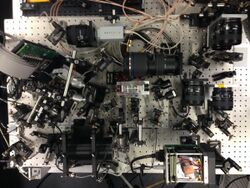Nuller
Topic: Astronomy
 From HandWiki - Reading time: 2 min
From HandWiki - Reading time: 2 min
A nuller is an optical tool used to block a strong source so that fainter signals near that source can be observed. An example of a nuller is being employed on the Keck Interferometer. This causes the light from a star to destructively interfere, effectively cancelling the star's image. As a result, the faint light from a ring of dust orbiting the star can then be detected. This project is part of a scientific effort to detect and observe nearby planets.
Interferometry
Nulling interferometry is a type of interferometry in which two or more signals are mixed to produce observational regions in which the incoming signals cancel themselves out. This creates a set of virtual "blind spots" which prevent unwanted signals from those areas from interfering with weaker nearby signals.
In 1978 Australian-American astronomer Ronald N. Bracewell suggested using nulling interferometry to search for planets around other stars.[1][2] This technique was considered for use by both the Terrestrial Planet Finder (a canceled NASA mission) and Darwin (a canceled ESA mission). It is being used on the Keck Interferometer.
A different technique is called a coronagraph, using a physical obstacle to block the unwanted signals.
Experimental nullers
There has been a nuller built by the Jet Propulsion Laboratory that has flown on a NASA sounding rocket twice, once in 2011 and a second time in 2015. There is also a laboratory nuller at NASA Goddard Space Flight Center known as the Visible Nulling Coronagraph (VNC) that is actively conducting experiments.[citation needed]
See also
References
- ↑ Bracewell, Ronald N. (1978), "Detecting nonsolar planets by spinning infrared interferometer", Nature 274 (5673): 780–781, 1978-08-24, doi:10.1038/274780a0, ISSN 0028-0836, Bibcode: 1978Natur.274..780B
- ↑ Bracewell, Ronald N.; MacPhie, Robert H. (1979), "Searching for nonsolar planets", Icarus 38 (1): 136–147, 1979-04-01, doi:10.1016/0019-1035(79)90093-9, ISSN 0019-1035, Bibcode: 1979Icar...38..136B
External links
- Interferometric Nulling at TNO
- Nulling interferometer basics
- Tutorial on nulling interferometry
- Progress Toward Astronomical Nulling (Criteria governing efficacy of nulling interferometry), Chapter 10 of the Terrestrial Planet Finder (TPF): A NASA Origins Program to Search for Habitable Planets - JPL Publication 99-003, May 1999
- Interactive "virtual" interferometer
 |
 KSF
KSF
